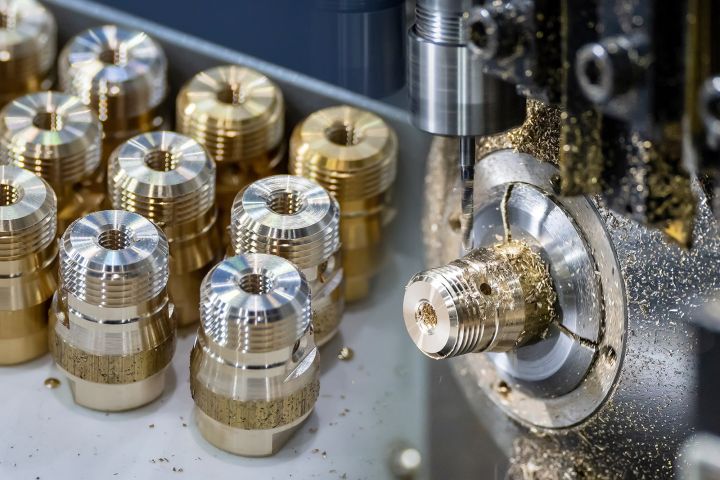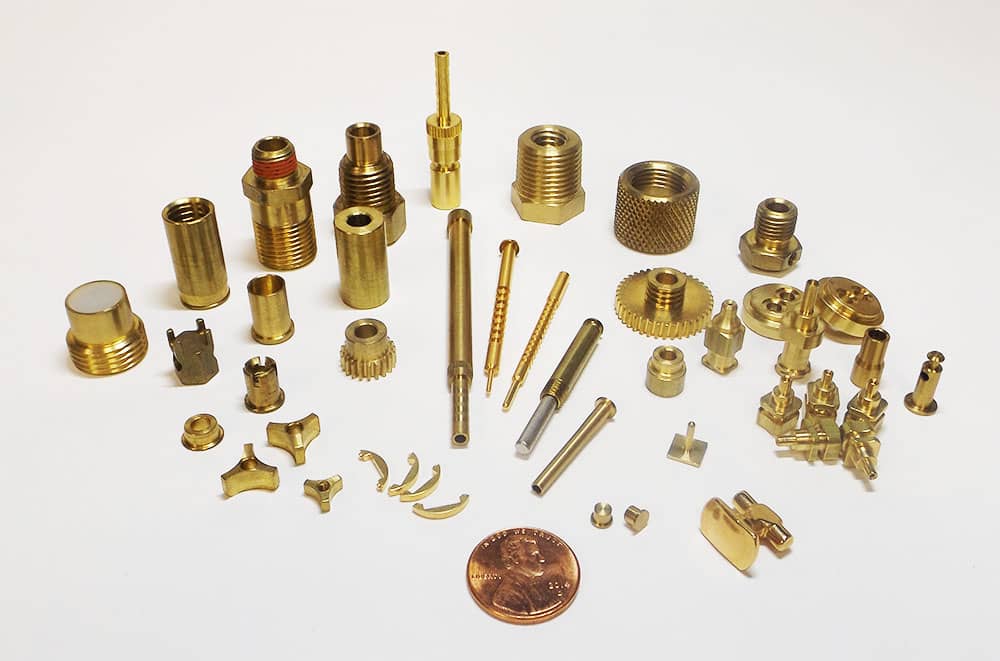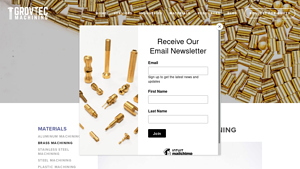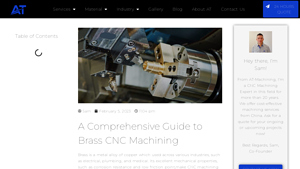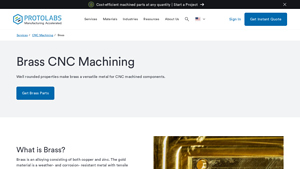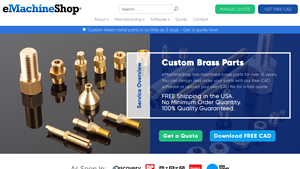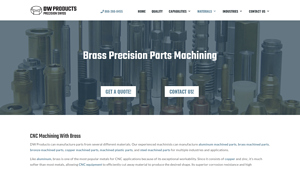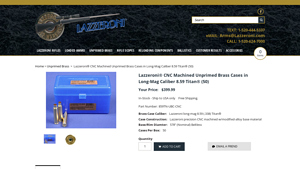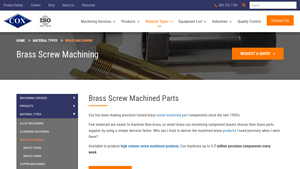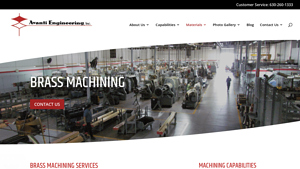Machined Brass Guide: Type, Cost, Top List…
Introduction: Navigating the Global Market for machined brass
Navigating the global market for machined brass presents a unique set of challenges for B2B buyers, particularly those sourcing components across diverse regions like Africa, South America, the Middle East, and Europe. With the increasing demand for high-quality brass parts in industries such as plumbing, electronics, and medical, the need for reliable sourcing strategies has never been more critical. This comprehensive guide delves into the intricacies of machined brass, addressing key considerations such as material properties, types of brass alloys, and their various applications.
Buyers will find valuable insights on how to effectively vet suppliers, assess pricing structures, and understand the nuances of production processes. From exploring the advantages of different brass grades—like low-leaded and free-cutting brass—to evaluating machining techniques such as CNC milling and EDM, this guide empowers international B2B buyers to make informed purchasing decisions.
By highlighting the essential factors influencing the procurement of machined brass components, this resource aims to streamline the sourcing process, ensuring that businesses can meet their operational needs with confidence. Whether you are a buyer in Nigeria seeking corrosion-resistant fittings or a manufacturer in Brazil looking for precise electronic components, this guide serves as your roadmap to successful brass procurement in a competitive global marketplace.
Understanding machined brass Types and Variations
| Type Name | Key Distinguishing Features | Primary B2B Applications | Brief Pros & Cons for Buyers |
|---|---|---|---|
| Red Brass | Excellent corrosion resistance, ideal for hot/cold working | Marine fittings, valves, weather stripping | Pros: High durability; Cons: Less machinable than other types |
| Cartridge Brass | High ductility, suitable for severe cold deformations | Electrical components, plumbing parts | Pros: Versatile; Cons: Lower corrosion resistance |
| Free Cutting Brass | Highest machinability rating, ideal for precision parts | Fluid connectors, threaded inserts | Pros: Cost-effective; Cons: Limited strength compared to others |
| Low-Leaded Brass | Good corrosion resistance, easy to machine | Pump cylinder liners, J-bends | Pros: Good balance of properties; Cons: Not suitable for all applications |
| Forging Brass | Excellent hot forgeability, good for complex shapes | Furniture hardware, golf club heads | Pros: High strength; Cons: More expensive due to complexity |
What Are the Characteristics of Red Brass in Machined Brass?
Red brass is notable for its excellent corrosion resistance, making it particularly suitable for applications in marine environments and plumbing. Composed primarily of copper and zinc, it can withstand harsh conditions without significant degradation. For B2B buyers, the key consideration is its durability, but it is less machinable compared to other brass types. This can impact production timelines and costs, especially for high-volume projects.
How Does Cartridge Brass Stand Out Among Machined Brass Types?
Cartridge brass, known for its high ductility, is ideal for applications requiring severe cold deformations, such as in electrical components and plumbing fittings. Its ability to be easily formed into intricate shapes makes it a popular choice among manufacturers. However, buyers should note its lower corrosion resistance, which may limit its use in certain environments. Understanding the specific application requirements is crucial for making informed purchasing decisions.
Why Choose Free Cutting Brass for Precision Manufacturing?
Free cutting brass is recognized for its exceptional machinability, earning a rating of 100, which makes it ideal for high-precision applications like fluid connectors and threaded inserts. This type of brass allows for faster production rates, resulting in cost savings for manufacturers. However, its strength is comparatively lower than other brass types, which should be considered for applications requiring high structural integrity.
What Are the Benefits of Low-Leaded Brass in B2B Applications?
Low-leaded brass is characterized by its good corrosion resistance and ease of machining, making it suitable for applications like pump cylinder liners and J-bends. This alloy provides a balanced performance, combining durability with machinability, which is appealing to many B2B buyers. However, it may not be ideal for every application, so understanding the specific needs of the project is essential for optimal selection.
How Does Forging Brass Compare to Other Machined Brass Variants?
Forging brass stands out due to its excellent hot forgeability and strength, making it suitable for complex shapes found in furniture hardware and sporting goods like golf club heads. While it offers high durability, the complexity of forging can lead to increased production costs. Buyers should assess whether the enhanced properties justify the investment for their specific applications, particularly in industries where strength is paramount.
Key Industrial Applications of machined brass
| Industry/Sector | Specific Application of machined brass | Value/Benefit for the Business | Key Sourcing Considerations for this Application |
|---|---|---|---|
| Plumbing | Brass fittings and valves | High corrosion resistance ensures longevity. | Ensure compliance with international plumbing standards. |
| Electrical | Connectors and circuit components | Excellent conductivity for reliable performance. | Evaluate material grade for electrical specifications. |
| Automotive | Engine components and fasteners | Lightweight yet durable, enhancing fuel efficiency. | Focus on precision machining capabilities and certifications. |
| Medical Devices | Surgical instruments and implants | Biocompatibility and corrosion resistance for safety. | Verify quality control processes and regulatory compliance. |
| Aerospace | Structural components and fittings | High strength-to-weight ratio for performance. | Assess machining tolerances and material certifications. |
How Is Machined Brass Used in Plumbing Applications?
In the plumbing industry, machined brass is primarily utilized for manufacturing fittings and valves. Its inherent corrosion resistance and durability make it ideal for water and gas applications, ensuring a long lifespan even in harsh environments. International buyers must prioritize suppliers who adhere to local plumbing standards, ensuring that the machined brass parts meet quality and safety regulations. Additionally, the ability to customize components for specific plumbing systems can enhance operational efficiency.
What Role Does Machined Brass Play in Electrical Applications?
Machined brass is crucial in the electrical sector, especially for connectors and circuit components. Its excellent electrical conductivity and low friction properties ensure reliable connections, which is vital for the performance of electrical devices. B2B buyers should consider the specific brass alloy grades that suit their electrical requirements, as variations can affect conductivity and heat resistance. Sourcing from manufacturers with a track record in electrical applications can mitigate risks associated with component failure.
Why Is Machined Brass Important for Automotive Components?
In the automotive industry, machined brass is often used for engine components and fasteners. Its lightweight nature contributes to improved fuel efficiency while maintaining strength and durability under high-stress conditions. Buyers from regions like Africa and South America should focus on suppliers that offer precise machining capabilities, as tolerances are critical for automotive applications. Additionally, understanding the specific environmental conditions where the vehicles will operate can guide material selection.
How Does Machined Brass Enhance Medical Devices?
Machined brass finds essential applications in medical devices, including surgical instruments and implants. Its biocompatibility and corrosion resistance are critical for ensuring patient safety and device longevity. Buyers in this sector must prioritize manufacturers with stringent quality control processes and certifications that comply with international medical device regulations. This diligence not only ensures safety but also enhances the reputation of the buyer’s products in a competitive market.
What Advantages Does Machined Brass Provide in Aerospace Applications?
In the aerospace industry, machined brass is utilized for structural components and fittings due to its high strength-to-weight ratio, which is vital for aircraft performance. Components must endure extreme conditions, making sourcing from manufacturers with high precision machining capabilities essential. International buyers should also verify that the brass used meets specific aerospace material certifications, ensuring compliance with rigorous industry standards and enhancing overall safety and reliability in their applications.
3 Common User Pain Points for ‘machined brass’ & Their Solutions
Scenario 1: Challenges in Sourcing Quality Machined Brass Components
The Problem:
B2B buyers often struggle with sourcing high-quality machined brass components that meet their specific requirements. This issue is particularly pronounced for companies operating in sectors like electronics or plumbing, where precision and durability are paramount. Many buyers face difficulties in finding reliable suppliers who can deliver components that not only conform to their technical specifications but also offer consistent quality over time. Additionally, fluctuating prices and varying lead times can complicate procurement processes, leading to project delays and increased costs.
The Solution:
To mitigate these challenges, B2B buyers should prioritize establishing long-term relationships with reputable suppliers who specialize in machined brass. Conduct thorough research to identify suppliers with proven track records in quality assurance and customer satisfaction. Request samples of machined brass components and perform rigorous testing to ensure they meet your specifications before placing larger orders. Additionally, consider using supplier performance metrics to track lead times, quality consistency, and pricing trends. Establishing clear communication about your requirements and expectations will also help in aligning with your suppliers, ultimately ensuring a more reliable procurement process.
Scenario 2: Inconsistent Quality in Machined Brass Parts
The Problem:
Another significant pain point for B2B buyers is the inconsistency in the quality of machined brass parts. Variations in the material properties, such as corrosion resistance or machinability, can lead to defective products, causing operational inefficiencies and potential safety hazards. This problem is particularly critical in industries like medical devices and aerospace, where even minor discrepancies can have serious implications. Buyers often find themselves navigating a minefield of poor-quality components that fail to meet industry standards.
The Solution:
To address the issue of inconsistent quality, B2B buyers should implement a stringent quality control process that includes both pre- and post-manufacturing inspections. Clearly outline quality standards in your purchase agreements, specifying the required tolerances, surface finishes, and material certifications. Additionally, consider collaborating with suppliers who use advanced machining techniques such as CNC machining, which can enhance precision and repeatability. Regular audits of supplier facilities can also help ensure compliance with your quality expectations, thereby reducing the likelihood of defects in machined brass parts.
Scenario 3: Difficulty in Customizing Machined Brass for Specific Applications
The Problem:
Customization is often a significant requirement for B2B buyers dealing with machined brass components, especially when unique designs or specifications are involved. However, many buyers find it challenging to communicate their specific needs effectively, leading to suboptimal designs that may not perform as intended. This is particularly problematic in sectors like automotive or industrial machinery, where tailored components are essential for optimal functionality. The lack of adequate customization can result in wasted resources and increased production costs.
The Solution:
To overcome customization challenges, B2B buyers should invest in the use of advanced design tools such as CAD software, which can facilitate precise communication of design specifications to suppliers. Engaging in collaborative design sessions with your supplier can also help in refining your specifications and ensuring feasibility. Consider conducting prototyping to test designs before final production; this allows for necessary adjustments to be made without incurring significant costs. Lastly, choose suppliers who offer flexible manufacturing capabilities, as they are more likely to accommodate custom requests and adapt to your evolving needs. This proactive approach will ultimately lead to better-fitting machined brass components that enhance overall product performance.
Strategic Material Selection Guide for machined brass
What Are the Key Properties of Common Brass Alloys for Machining?
Brass is a versatile alloy primarily composed of copper and zinc, with various grades tailored for specific applications. Understanding the properties and applications of different brass materials is crucial for B2B buyers looking to optimize their production processes. Here, we analyze four common brass alloys used in machining, focusing on their properties, pros and cons, and implications for international buyers.
1. Cartridge Brass (C26000)
Key Properties: Cartridge brass, known for its excellent ductility and cold working properties, has a melting point of approximately 900°C and offers good corrosion resistance.
Pros & Cons: The high ductility allows for severe cold deformation, making it suitable for complex shapes. However, its lower strength compared to other brass types can be a limitation in high-stress applications.
Impact on Application: Cartridge brass is ideal for components like electrical connectors and plumbing fittings, where flexibility and corrosion resistance are essential. Its compatibility with various fluids makes it a preferred choice in plumbing and automotive applications.
Considerations for International Buyers: Compliance with international standards such as ASTM B36 and EN 12164 is critical. Buyers from regions like Africa and South America should consider local sourcing options to reduce lead times and costs.
2. Free-Cutting Brass (C36000)
Key Properties: This alloy boasts the highest machinability rating of 100, with excellent surface finish capabilities and a low melting point of around 900°C.
Pros & Cons: The primary advantage is its ease of machining, which reduces manufacturing time and costs. However, its lower strength and corrosion resistance compared to other brass types may limit its use in certain applications.
Impact on Application: Free-cutting brass is commonly used in manufacturing fasteners, fittings, and intricate components where precision is critical. Its low friction properties enhance performance in mechanical applications.
Considerations for International Buyers: Buyers must ensure that their suppliers adhere to machining standards like ISO 9001 for quality assurance. Additionally, understanding local regulations regarding lead content is essential for compliance.
3. Yellow Brass (C27000)
Key Properties: Yellow brass is characterized by its good strength and corrosion resistance, with a melting point of approximately 900°C. It also exhibits excellent soldering and brazing properties.
Pros & Cons: Its strength makes it suitable for structural applications, but it is harder to machine than free-cutting brass, which can increase manufacturing complexity and costs.
Impact on Application: Commonly used in decorative applications, hardware, and plumbing fixtures, yellow brass is favored for its aesthetic appeal and durability.
Considerations for International Buyers: Buyers should be aware of the aesthetic preferences in their markets, particularly in Europe and the Middle East, where decorative finishes may be more valued. Compliance with standards like EN 12165 is also essential.
4. Low-Leaded Brass (C33000)
Key Properties: This alloy combines good machinability with excellent corrosion resistance, making it suitable for various applications. It has a melting point similar to other brass types, around 900°C.
Pros & Cons: The low lead content enhances safety and compliance with health regulations, but it may not machine as easily as free-cutting brass, potentially increasing production costs.
Impact on Application: Low-leaded brass is ideal for applications in the medical and food industries, where corrosion resistance and safety are paramount.
Considerations for International Buyers: Buyers must ensure that suppliers meet stringent health and safety regulations, especially in regions like Europe, where lead content is heavily regulated. Understanding local standards is crucial for market entry.
Summary Table of Brass Alloys for Machined Brass
| Material | Typical Use Case for machined brass | Key Advantage | Key Disadvantage/Limitation | Relative Cost (Low/Med/High) |
|---|---|---|---|---|
| Cartridge Brass (C26000) | Electrical connectors, plumbing fittings | Excellent ductility and corrosion resistance | Lower strength compared to others | Medium |
| Free-Cutting Brass (C36000) | Fasteners, intricate components | Highest machinability rating | Lower strength and corrosion resistance | Low |
| Yellow Brass (C27000) | Decorative hardware, plumbing fixtures | Good strength and aesthetic appeal | Harder to machine | Medium |
| Low-Leaded Brass (C33000) | Medical and food applications | Enhanced safety and corrosion resistance | May not machine as easily | High |
This guide serves as a strategic resource for B2B buyers, enabling informed decisions when selecting machined brass materials suitable for their specific applications and market needs.
In-depth Look: Manufacturing Processes and Quality Assurance for machined brass
What Are the Main Stages in the Manufacturing Process of Machined Brass?
The manufacturing process of machined brass typically involves several key stages: material preparation, forming, assembly, and finishing. Each stage is critical to ensuring the quality and functionality of the final product.
Material Preparation: How is Brass Processed Before Machining?
Before machining, brass is prepared through several steps. First, raw brass is sourced, often in the form of bars or sheets. The material is then cut to size, ensuring it meets the specifications required for the machining process. This initial step is crucial, as it minimizes waste and optimizes the machining process. The quality of the brass material itself—its alloy composition and physical properties—plays a significant role in determining the final product’s durability and performance.
What Techniques Are Used in Forming Brass Components?
Once prepared, the forming process can begin. Common techniques include CNC milling, CNC turning, and waterjet cutting. CNC milling employs rotating tools to carve intricate shapes, allowing for high precision and tight tolerances. CNC turning, on the other hand, involves rotating the brass material against a stationary cutting tool, primarily used for cylindrical components. Waterjet cutting is ideal for creating flat parts with clean edges without altering the material’s properties. Each technique has its advantages depending on the complexity and intended use of the component.
How is Assembly Conducted in Brass Manufacturing?
For many machined brass components, assembly is a crucial step. Components are often produced as individual parts before being assembled into larger systems, such as valves or fittings. This may involve soldering or brazing, especially for parts that require a permanent joint. In some cases, pre-assembly inspections are conducted to ensure that each component meets the necessary specifications before final assembly.
What Finishing Processes Are Commonly Applied to Machined Brass?
The finishing stage is essential for enhancing the appearance and functionality of machined brass parts. Common finishing techniques include polishing, anodizing, plating, and powder coating. These processes not only improve the aesthetic quality of the brass components but also increase corrosion resistance and wear durability. Choosing the right finishing process is essential for applications in industries such as plumbing, electronics, and automotive, where both function and appearance matter.
What Quality Assurance Standards Are Relevant for Machined Brass?
Quality assurance (QA) in the manufacturing of machined brass is vital for ensuring consistency and reliability. International standards such as ISO 9001 provide a framework for quality management systems, emphasizing continuous improvement and customer satisfaction. For specific industries, additional certifications may be required. For instance, CE marking is essential for products sold in the European market, while API standards are crucial for oil and gas applications.
What Are the Key QC Checkpoints in Brass Manufacturing?
Quality control (QC) checkpoints are implemented throughout the manufacturing process to ensure that each component meets predefined standards. These checkpoints typically include:
- Incoming Quality Control (IQC): This initial stage involves inspecting raw materials upon arrival to verify compliance with specifications.
- In-Process Quality Control (IPQC): During the manufacturing process, periodic checks are conducted to monitor critical parameters and ensure adherence to quality standards.
- Final Quality Control (FQC): This stage involves a comprehensive inspection of finished products before they are shipped. It includes dimensional checks, surface finish evaluations, and functional testing.
How Can B2B Buyers Verify Supplier Quality Control?
For international B2B buyers, especially those from regions like Africa, South America, the Middle East, and Europe, verifying a supplier’s quality control practices is crucial. Here are some strategies:
- Supplier Audits: Conducting on-site audits allows buyers to assess the manufacturer’s quality management systems and production processes firsthand.
- Quality Reports: Requesting detailed quality assurance reports can provide insights into the supplier’s compliance with international standards and their internal QC procedures.
- Third-Party Inspections: Engaging third-party inspection services offers an independent assessment of product quality and adherence to specifications. This can be particularly useful for large orders or when establishing new supplier relationships.
What Testing Methods Are Commonly Used in Brass Quality Assurance?
Testing methods play a critical role in the quality assurance of machined brass components. Common techniques include:
- Dimensional Inspection: Utilizing tools like calipers and micrometers to ensure that parts meet specified tolerances.
- Mechanical Testing: This includes tensile tests to measure strength and ductility, as well as hardness tests to assess material properties.
- Corrosion Testing: Evaluating the corrosion resistance of brass components is essential, especially for applications in harsh environments.
- Non-Destructive Testing (NDT): Methods such as ultrasonic testing can detect internal defects without damaging the components, ensuring structural integrity.
How Do Quality Control Nuances Affect International B2B Buyers?
B2B buyers must navigate various quality control nuances when sourcing machined brass internationally. Different countries may have specific regulations and standards that affect production and certification. Understanding these differences is crucial for ensuring compliance and avoiding potential issues with imports.
Buyers should also be aware of the cultural and operational practices of suppliers in different regions. For instance, suppliers in Europe may emphasize stringent quality controls, while those in developing regions may have varying levels of resources dedicated to QA. Building strong relationships with suppliers and engaging in open communication can help mitigate these differences.
Conclusion: Why Quality Assurance is Essential in Machined Brass Manufacturing
For B2B buyers, understanding the manufacturing processes and quality assurance practices in machined brass is essential for ensuring product reliability and performance. By focusing on key manufacturing stages, verifying supplier quality control, and adhering to international standards, businesses can successfully source high-quality brass components that meet their specific needs. Whether operating in Africa, South America, the Middle East, or Europe, a strategic approach to quality assurance will enhance procurement outcomes and foster long-term supplier relationships.
Practical Sourcing Guide: A Step-by-Step Checklist for ‘machined brass’
Introduction
This sourcing guide is designed to assist B2B buyers in procuring machined brass components effectively. By following this step-by-step checklist, you can ensure that your procurement process is thorough, efficient, and tailored to meet your specific needs.
Step 1: Define Your Technical Specifications
Establishing precise technical specifications is crucial for successful procurement. Detail the dimensions, tolerances, surface finishes, and any additional requirements specific to your application, such as corrosion resistance or electrical conductivity. This clarity will help you communicate effectively with potential suppliers and ensure that the final product meets your operational standards.
Step 2: Identify Suitable Brass Alloys
Understanding the different brass alloys and their properties will guide you in selecting the right material for your project. Common options include cartridge brass for high ductility, yellow brass for strength, and free-cutting brass for superior machinability. Evaluate which alloy aligns best with your performance requirements and industry standards.
Step 3: Evaluate Potential Suppliers
Before committing to a supplier, conducting a thorough evaluation is essential. Look for suppliers with a solid track record in brass machining, and request company profiles, case studies, and references from previous clients, particularly those in similar industries or regions. This diligence helps ensure reliability and quality in your procurement.
- Consider their production capabilities: Ensure they can meet your volume needs and delivery schedules.
- Assess their technology and machinery: Suppliers should utilize advanced CNC machining techniques to guarantee precision.
Step 4: Verify Quality Certifications
Quality assurance is paramount when sourcing machined brass parts. Verify that potential suppliers hold relevant quality certifications, such as ISO 9001, which indicates a commitment to maintaining high manufacturing standards. This step not only mitigates risks associated with defects but also enhances confidence in the supplier’s ability to deliver consistent quality.
Step 5: Request Samples and Quotes
Once you have narrowed down your supplier options, request samples of their machined brass components. This allows you to evaluate the quality, finish, and adherence to specifications firsthand. Additionally, obtaining quotes from multiple suppliers helps you compare pricing structures and negotiate terms effectively.
- Look for transparency in pricing: Ensure that quotes include all costs, such as shipping and handling, to avoid surprises later.
- Evaluate lead times: Consider the time required for production and delivery, which can significantly impact your project timelines.
Step 6: Discuss Terms and Conditions
Before finalizing your order, have a clear discussion about terms and conditions. This includes payment terms, return policies, and warranties. Establishing these parameters upfront can prevent misunderstandings and protect your investment.
Step 7: Establish a Communication Plan
Effective communication is vital throughout the sourcing process. Set up regular check-ins with your supplier to monitor progress, address any issues, and make adjustments as needed. This proactive approach can enhance collaboration and ensure that your requirements are met in a timely manner.
By following these steps, you can streamline your procurement process for machined brass, ensuring that you select the right materials and suppliers to meet your business needs.
Comprehensive Cost and Pricing Analysis for machined brass Sourcing
What Are the Key Cost Components in Machined Brass Sourcing?
When sourcing machined brass, understanding the cost structure is crucial for effective budgeting and procurement strategies. The primary cost components include:
-
Materials: Brass alloys, primarily composed of copper and zinc, are the foundation of the costs. The price fluctuates based on market demand for copper and zinc, as well as the specific brass grade required for your application (e.g., free cutting brass for high machinability).
-
Labor: Labor costs encompass the wages of skilled machinists and operators involved in the CNC machining process. Skilled labor is essential for ensuring precision and quality, impacting the overall pricing significantly.
-
Manufacturing Overhead: This includes costs associated with running the manufacturing facility, such as utilities, maintenance, and equipment depreciation. Efficient facilities may pass on savings to buyers, making it a critical factor.
-
Tooling: Tooling costs are incurred for the specialized tools and machinery necessary for machining brass. High-quality tools are required for intricate designs and tight tolerances, which can increase initial setup costs but improve long-term efficiency.
-
Quality Control (QC): Ensuring that machined brass parts meet industry standards and specifications requires investment in QC processes. This can involve testing, inspection, and certification, which are essential for maintaining product integrity.
-
Logistics: Shipping and handling costs are vital, especially for international buyers. Factors like distance, shipping method, and customs duties play a significant role in the total cost.
-
Margin: Suppliers will include a profit margin in their pricing, which can vary based on competition, market conditions, and the perceived value of the product.
How Do Price Influencers Affect Machined Brass Costs?
Several factors can influence the pricing of machined brass components, including:
-
Volume and Minimum Order Quantity (MOQ): Larger orders typically reduce the per-unit cost due to economies of scale. Suppliers may offer better pricing for higher volumes, making it advantageous for buyers to consolidate orders.
-
Specifications and Customization: Customized parts with specific tolerances or unique designs generally incur higher costs. Standardized parts are more cost-effective due to simplified manufacturing processes.
-
Material Quality and Certifications: High-quality materials and certifications (such as ISO or ASTM) can raise costs but provide assurance of durability and compliance with industry standards, which may be essential for certain applications.
-
Supplier Factors: The reputation and reliability of the supplier can impact pricing. Established suppliers with a track record of quality may charge a premium, while newer entrants may offer competitive pricing to gain market share.
-
Incoterms: Understanding the terms of shipment and responsibility (Incoterms) is crucial for international buyers. Terms like FOB (Free on Board) or CIF (Cost, Insurance, and Freight) can affect the overall cost and risk associated with the procurement process.
What Are the Best Practices for Negotiating Brass Pricing?
Effective negotiation strategies can lead to better pricing and cost efficiency:
-
Leverage Volume Discounts: When possible, consolidate orders to achieve higher volumes, which can trigger discounts from suppliers.
-
Understand Total Cost of Ownership (TCO): Consider not just the purchase price but also long-term costs related to quality, durability, and maintenance. Investing in higher-quality brass may reduce failures and replacements.
-
Build Relationships with Suppliers: Establishing a good rapport can lead to better pricing, priority service, and favorable terms.
-
Research Market Prices: Stay informed about market trends and prices for raw materials like copper and zinc. This knowledge can provide leverage during negotiations.
-
Consider Local Suppliers: For buyers in regions like Africa and South America, sourcing locally may reduce logistics costs and lead times, while also fostering regional economic growth.
Final Thoughts on Machined Brass Sourcing
While the pricing for machined brass can vary widely based on numerous factors, understanding the intricacies of cost components and price influencers enables international B2B buyers to make informed decisions. Always approach negotiations with a clear strategy and an understanding of the total cost implications, ensuring that the chosen supplier aligns with your quality and budgetary requirements.
Disclaimer: Pricing for machined brass components can fluctuate based on market conditions and specific project requirements; therefore, always seek updated quotes from suppliers.
Alternatives Analysis: Comparing machined brass With Other Solutions
Exploring Alternative Materials to Machined Brass
When considering materials for precision machining, it’s vital to evaluate alternatives to machined brass. Each material has its unique properties, costs, and best-use cases that can significantly impact production efficiency and product quality. Below, we compare machined brass with two notable alternatives: aluminum and stainless steel.
| Comparison Aspect | Machined Brass | Aluminum | Stainless Steel |
|---|---|---|---|
| Performance | Excellent corrosion resistance and electrical conductivity; good machinability. | Lightweight with good strength-to-weight ratio; less corrosion resistance unless alloyed. | High strength and durability; excellent corrosion resistance in various environments. |
| Cost | Generally moderate cost; price may fluctuate based on copper and zinc market. | Typically lower cost than brass; prices can vary based on alloy and volume. | Higher initial cost but offers longevity and low maintenance, potentially lowering lifecycle costs. |
| Ease of Implementation | Easy to machine with standard tools; familiar to most machinists. | Also easy to machine, but may require specialized tools for certain alloys. | More challenging to machine; requires specific tools and expertise. |
| Maintenance | Low maintenance; resistant to wear and corrosion. | Moderate maintenance; susceptible to corrosion without proper treatment. | Very low maintenance; highly resistant to corrosion and wear. |
| Best Use Case | Ideal for electrical components, plumbing fixtures, and decorative applications. | Best suited for lightweight applications, automotive parts, and consumer products. | Preferred for structural applications, food processing, and medical devices due to its strength and corrosion resistance. |
In-Depth Analysis of Alternative Materials
Aluminum
Aluminum is a lightweight metal known for its excellent strength-to-weight ratio. It is often used in industries requiring reduced weight without sacrificing performance, such as aerospace and automotive. While aluminum is typically less expensive than brass, it has lower corrosion resistance unless treated with anodizing or other protective coatings. Machining aluminum is straightforward, though certain alloys may require specialized tooling to achieve precise tolerances. For applications where weight is a critical factor, aluminum can be an excellent alternative, though it may not match brass’s electrical conductivity.
Stainless Steel
Stainless steel is renowned for its exceptional strength and corrosion resistance, making it a top choice for demanding environments. It is commonly used in food processing, medical devices, and construction. While the initial cost of stainless steel is usually higher than that of brass, its longevity and low maintenance requirements can lead to lower total lifecycle costs. Machining stainless steel can be more complex, requiring specialized tools and knowledge, which may increase production times and costs. However, for applications requiring durability and resistance to harsh conditions, stainless steel is often the superior choice.
Making the Right Choice for Your B2B Needs
Choosing the right material for your machining needs involves balancing performance, cost, and application requirements. If your application demands excellent conductivity and aesthetic appeal, machined brass may be the best option. However, if weight reduction is paramount, aluminum could be the better choice. For applications that require maximum durability and corrosion resistance, stainless steel stands out as the ideal alternative. By carefully evaluating these factors, B2B buyers can select the material that best aligns with their project goals and operational needs, ensuring optimal performance and cost-efficiency in their manufacturing processes.
Essential Technical Properties and Trade Terminology for machined brass
What Are the Key Technical Properties of Machined Brass for B2B Buyers?
Understanding the technical properties of machined brass is crucial for B2B buyers looking to make informed purchasing decisions. Here are several critical specifications that significantly impact the performance and suitability of brass components in various applications:
1. Material Grade
Brass is an alloy primarily composed of copper and zinc, with various grades available, each tailored for specific applications. Common grades include C36000 (Free Cutting Brass), C26000 (Cartridge Brass), and C24000 (Low Brass). Each grade offers distinct characteristics like machinability, corrosion resistance, and mechanical strength. Selecting the right grade is vital for ensuring that the final product meets operational requirements while optimizing production costs.
2. Tolerance
Tolerance refers to the permissible limit or limits of variation in a physical dimension. For machined brass components, tight tolerances (e.g., ±0.01 mm) are often necessary, especially in precision industries such as aerospace and electronics. Adhering to specified tolerances ensures that parts fit correctly and function as intended, reducing the risk of failures or costly reworks.
3. Corrosion Resistance
Brass exhibits excellent corrosion resistance, particularly when exposed to moisture and various chemicals. The presence of zinc enhances this property, making brass suitable for plumbing, marine, and electrical applications. Understanding the corrosion resistance of specific brass grades helps B2B buyers select materials that will maintain their integrity in demanding environments, ultimately prolonging the lifespan of the components.
4. Electrical Conductivity
Brass is known for its good electrical conductivity, making it a popular choice for electrical components such as connectors and terminals. The copper content in brass significantly contributes to this property. B2B buyers in the electronics sector should prioritize brass grades with higher copper percentages to ensure optimal performance in electrical applications.
5. Thermal Conductivity
Similar to electrical conductivity, thermal conductivity is another essential property of brass. Brass can effectively conduct heat, which is critical in applications like heat exchangers and radiators. Buyers should consider the thermal conductivity of different brass grades to ensure efficient heat transfer in their specific applications.
6. Machinability Rating
Machinability indicates how easily a material can be machined to desired specifications. Brass typically boasts a high machinability rating, especially grades like C36000, which is often used as a benchmark. A higher machinability rating translates to lower production costs and shorter lead times, making it an attractive choice for manufacturers.
What Are Common Trade Terms Related to Machined Brass?
Navigating the procurement landscape for machined brass involves understanding industry jargon. Here are some common terms that are essential for B2B buyers:
1. OEM (Original Equipment Manufacturer)
An OEM is a company that produces parts or equipment that may be marketed by another manufacturer. For buyers, working with reputable OEMs ensures that the machined brass components meet industry standards and specifications.
2. MOQ (Minimum Order Quantity)
MOQ refers to the smallest quantity of a product that a supplier is willing to sell. Understanding MOQs is crucial for B2B buyers as it can affect inventory management and cash flow. Buyers should negotiate MOQs based on their project needs and budget constraints.
3. RFQ (Request for Quotation)
An RFQ is a document used to invite suppliers to bid on specific products or services. For machined brass, an RFQ should detail specifications, quantities, and delivery timelines. This process helps buyers compare pricing and services from multiple suppliers to make informed decisions.
4. Incoterms (International Commercial Terms)
Incoterms are a set of international rules that define the responsibilities of sellers and buyers in international transactions. Familiarity with Incoterms is essential for B2B buyers engaged in global sourcing of machined brass, as they dictate shipping, insurance, and risk management responsibilities.
5. Lead Time
Lead time refers to the time taken from placing an order to delivery. Understanding lead times for machined brass components helps buyers plan their projects effectively, ensuring that production schedules are met without delays.
By grasping these technical properties and trade terminology, B2B buyers can enhance their procurement processes, ensuring they select the right machined brass components for their specific needs.
Navigating Market Dynamics and Sourcing Trends in the machined brass Sector
What are the Current Market Dynamics and Key Trends in the Machined Brass Sector?
The machined brass market is experiencing significant growth, driven by its versatile applications across various industries, including plumbing, electronics, automotive, and medical sectors. Key market dynamics include increasing demand for high-quality machined components, driven by advancements in technology and manufacturing processes. For international B2B buyers, particularly from regions such as Africa, South America, the Middle East, and Europe, understanding these dynamics is crucial. Notably, the rise of Industry 4.0 technologies, including automation and data analytics, is streamlining manufacturing processes, enhancing precision, and reducing lead times.
Emerging trends include the customization of brass components to meet specific client requirements, which is facilitated by advanced CNC machining technologies. Additionally, the growing focus on lightweight materials is prompting innovation in brass formulations, leading to the development of alloys that offer improved strength-to-weight ratios. Buyers should also be aware of shifts in global sourcing strategies, as companies increasingly seek local suppliers to mitigate risks associated with international logistics and trade tensions.
Furthermore, the expansion of e-commerce platforms for industrial components is transforming how B2B transactions occur, providing buyers with easier access to suppliers and enabling quick comparisons of offerings. As a result, international buyers can expect a more competitive landscape, which can lead to cost savings and better quality products.
How is Sustainability Influencing Sourcing Decisions in the Machined Brass Industry?
Sustainability has become a pivotal factor in sourcing decisions within the machined brass sector. The environmental impact of manufacturing processes, including energy consumption and waste generation, is under scrutiny from both consumers and regulatory bodies. As a response, many suppliers are adopting sustainable practices, such as reducing energy use and implementing recycling programs for brass scrap.
For B2B buyers, the importance of ethical supply chains cannot be overstated. Companies are increasingly seeking suppliers that can demonstrate compliance with environmental standards and ethical sourcing practices. Certifications such as ISO 14001 (Environmental Management) and Fair Trade certifications are becoming essential criteria for selecting suppliers.
Moreover, the demand for ‘green’ materials is rising. Buyers are looking for brass alloys that incorporate recycled materials or use production processes that minimize environmental impact. By prioritizing sustainable sourcing, companies can not only enhance their brand reputation but also align with the growing consumer preference for environmentally responsible products.
How Has the Machined Brass Sector Evolved Over Time?
The evolution of the machined brass sector can be traced back to its origins as a favored material in plumbing and electrical applications due to its durability and corrosion resistance. Over the decades, advancements in manufacturing technologies, particularly CNC machining, have significantly enhanced the precision and efficiency of brass component production.
As industries have evolved, so too have the applications of machined brass. Today, it is not only used in traditional sectors but also in high-tech applications, such as medical devices and electronic hardware. The introduction of new brass alloys has broadened its usability, allowing for innovations in design and functionality.
In conclusion, understanding the historical context of machined brass provides valuable insights into its current market trends and future potential, equipping international B2B buyers with the knowledge needed to navigate this dynamic landscape effectively.
Frequently Asked Questions (FAQs) for B2B Buyers of machined brass
-
How do I select the right brass alloy for my application?
Choosing the appropriate brass alloy depends on the specific requirements of your application. Factors such as corrosion resistance, machinability, ductility, and electrical conductivity play crucial roles. For instance, if your application requires high corrosion resistance, consider using Red Brass or Low-Leaded Brass. Conversely, if you need excellent machinability and are manufacturing intricate components, Free Cutting Brass (360 Brass) is ideal. Conduct a thorough analysis of your operational needs and consult with suppliers to select the most suitable alloy for your project. -
What are the key benefits of using machined brass in manufacturing?
Machined brass offers several advantages, including excellent machinability, corrosion resistance, and good thermal and electrical conductivity. Its low friction coefficient makes it suitable for moving parts and applications requiring reduced wear. Additionally, brass components can be produced with high precision, ensuring tight tolerances and superior surface finishes. This versatility enables its use across various industries, including plumbing, electronics, and automotive, making it a reliable choice for B2B buyers seeking durable components. -
What is the typical lead time for ordering machined brass components?
Lead times for machined brass components can vary significantly based on factors such as order size, complexity, and supplier capabilities. Generally, expect a lead time of 2 to 6 weeks for standard orders. However, custom designs may require additional time for prototyping and adjustments. To ensure timely delivery, it’s advisable to communicate your needs clearly with suppliers and plan orders well in advance, especially for large-scale projects or those with tight deadlines. -
What minimum order quantities (MOQs) should I expect when sourcing machined brass?
Minimum order quantities for machined brass components can vary widely among suppliers. Some may offer no minimum order requirements, allowing you to order as few as one part, while others might set MOQs ranging from 100 to 1,000 units. It’s essential to discuss your specific needs with potential suppliers and understand their policies. If you’re working on a prototype or small-scale project, consider partnering with suppliers who are flexible with MOQs to avoid excess inventory. -
How can I ensure quality assurance (QA) for machined brass parts?
To ensure quality assurance for machined brass parts, request detailed documentation from suppliers regarding their QA processes. Look for certifications such as ISO 9001, which indicates adherence to quality management standards. Additionally, inquire about inspection procedures, including dimensional checks, material certifications, and surface finish evaluations. Consider requesting samples or conducting third-party inspections to validate the quality before committing to larger orders, especially for critical applications. -
What payment terms should I negotiate with my brass suppliers?
When negotiating payment terms with brass suppliers, aim for conditions that align with your cash flow and budget needs. Common terms include net 30, net 60, or upfront deposits ranging from 20% to 50% before production. For larger orders, you might negotiate favorable terms like extended payment periods or discounts for early payment. Ensure that all terms are clearly documented in your purchase agreements to avoid misunderstandings and establish a strong working relationship with your supplier. -
How do I vet suppliers for machined brass components?
Vetting suppliers for machined brass components involves several steps. Start by researching potential suppliers’ experience, industry reputation, and production capabilities. Request references and case studies to understand their track record. Evaluate their certifications and quality assurance processes to ensure compliance with industry standards. Additionally, consider visiting their facilities if possible, or conducting virtual audits to assess their operations. Building a strong relationship with a reputable supplier can significantly impact the success of your projects. -
What logistics considerations should I keep in mind when importing machined brass?
When importing machined brass components, consider logistics factors such as shipping methods, customs regulations, and import duties. Choose a reliable freight forwarder experienced in handling metal imports to ensure smooth transportation. Be aware of the documentation required for customs clearance, including invoices, packing lists, and certificates of origin. Additionally, factor in lead times for shipping and customs processing to avoid delays. Planning your logistics strategy early can help mitigate risks and ensure timely delivery of your components.
Important Disclaimer & Terms of Use
⚠️ Important Disclaimer
The information provided in this guide, including content regarding manufacturers, technical specifications, and market analysis, is for informational and educational purposes only. It does not constitute professional procurement advice, financial advice, or legal advice.
While we have made every effort to ensure the accuracy and timeliness of the information, we are not responsible for any errors, omissions, or outdated information. Market conditions, company details, and technical standards are subject to change.
B2B buyers must conduct their own independent and thorough due diligence before making any purchasing decisions. This includes contacting suppliers directly, verifying certifications, requesting samples, and seeking professional consultation. The risk of relying on any information in this guide is borne solely by the reader.
Top 8 Machined Brass Manufacturers & Suppliers List
1. Grovtec – Precision Brass Machining
Domain: grovtecmachining.com
Registered: 2014 (11 years)
Introduction: Brass machining services, precision brass machining, used in plumbing, oil and gas, medical and dental industries, excellent machining qualities, cost efficient, durable, low strength and weight properties, commonly used in electronics and high tech industries, combination of copper and zinc, improved properties with lead addition, versatile machining material.
2. AT Machining – CNC Machined Brass Components
Domain: at-machining.com
Registered: 2014 (11 years)
Introduction: Brass is a metal alloy of copper and zinc, used across various industries such as electrical, plumbing, and medical. It has excellent mechanical properties including corrosion resistance, low friction, high machinability, good ductility, and flexibility. CNC machining brass produces quality components with extreme precision and aesthetic surface finish, suitable for parts like light fixtures, pipe…
3. Protolabs – Brass CNC Machining
Domain: protolabs.com
Registered: 2006 (19 years)
Introduction: Brass CNC Machining for Custom Parts: Cost-efficient machined parts at any quantity. Brass is an alloy of copper and zinc, known for its weather- and corrosion-resistance, with tensile strength similar to mild steel. It is easy to machine, allowing for high feed rates and minimal coolant needs. Types of Brass: Brass C260 (70% copper, 30% zinc) – high ductility, general-purpose; Brass C360 – indust…
4. eMachineShop – Custom Brass Parts
Domain: emachineshop.com
Registered: 1999 (26 years)
Introduction: eMachineShop offers custom brass parts with over 15 years of experience in brass fabrication. Key features include:
– Free CAD software for design or the option to upload CAD files for quotes.
– Free shipping within the USA.
– No minimum order quantity.
– 100% quality guarantee.
Brass is an alloy of copper and zinc, known for its attractive gold appearance, non-magnetic properties, low coefficien…
5. DW Products – Brass CNC Machining
Domain: dwproducts.com
Registered: 2005 (20 years)
Introduction: Brass CNC Parts Machining Center at DW Products offers precision machining of brass parts. Key features include:
– Exceptional workability due to its composition of copper and zinc.
– Superior corrosion resistance and high conductivity, ideal for plumbing applications.
– Efficient cutting at higher speeds and faster feed rates without chipping or affecting surface finish.
– Cost savings over d…
6. Lazzeroni – CNC Machined Brass Cases
Domain: lazzeroni.com
Registered: 1996 (29 years)
Introduction: Lazzeroni® CNC Machined Unprimed Brass Cases in Long Mag Caliber 859 Titan® 50
7. Cox Manufacturing – Precision Brass Components
Domain: coxmanufacturing.com
Registered: 2003 (22 years)
Introduction: Cox Manufacturing specializes in brass screw machining and precision turned brass components. They have been producing these parts since the late 1950s and can manufacture up to 1.7 million precision components weekly. Key advantages of brass screw machined parts include durability, cost efficiency, high heat and corrosion resistance, and ease of machining. Common applications for brass CNC machin…
8. Avanti Engineering – Precision Brass Machining Services
Domain: avantiengineering.com
Registered: 2000 (25 years)
Introduction: Avanti Engineering specializes in high-precision brass machining services, producing durable, corrosion-resistant parts ideal for plumbing, machinery, and consumer products. Key features include:
– Over 50 years of experience and ISO 9001:2015 certification.
– Advanced CNC machining capabilities with tolerances down to +/- 0.005″.
– Wide range of brass alloys including C260, C360, C544.
– Appl…
Strategic Sourcing Conclusion and Outlook for machined brass
How Can Strategic Sourcing Enhance Your Machined Brass Procurement?
In conclusion, strategic sourcing of machined brass offers significant advantages for international B2B buyers, particularly in regions such as Africa, South America, the Middle East, and Europe. By understanding the unique properties of brass, including its excellent machinability, corrosion resistance, and versatility across various applications, buyers can make informed decisions that optimize their production processes. This material not only meets the demands of industries like plumbing, electronics, and medical but also presents cost-effective solutions that enhance durability and performance.
As you navigate the complexities of sourcing, consider collaborating with reputable manufacturers that offer customized machining solutions tailored to your specific needs. Leveraging advanced technologies such as CNC machining can further enhance precision and reduce lead times, ensuring your projects remain on schedule.
Looking ahead, the global demand for high-quality machined brass components is poised to grow, driven by ongoing industrial advancements. Now is the time to engage with strategic partners who can support your sourcing initiatives, thereby positioning your business for success in an increasingly competitive marketplace. Take action today to secure your supply chain and capitalize on the benefits that machined brass can offer.
